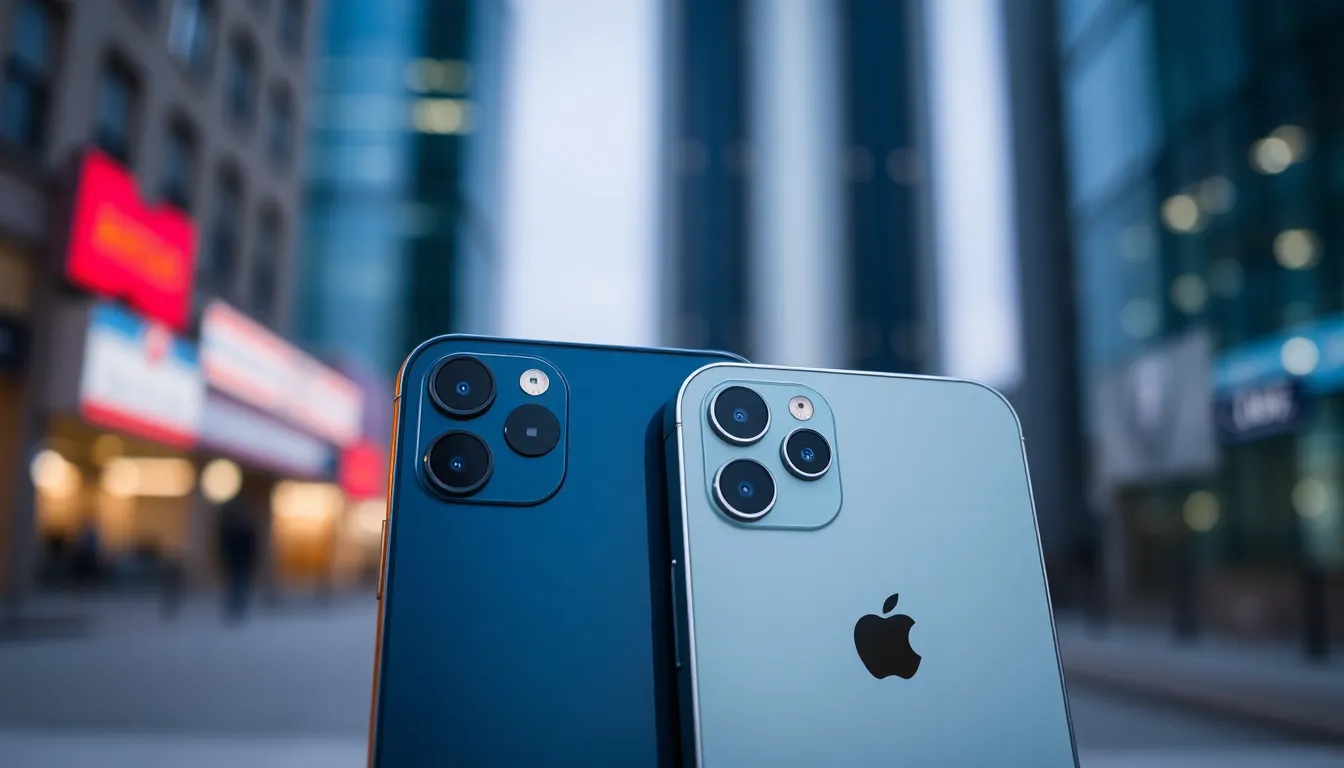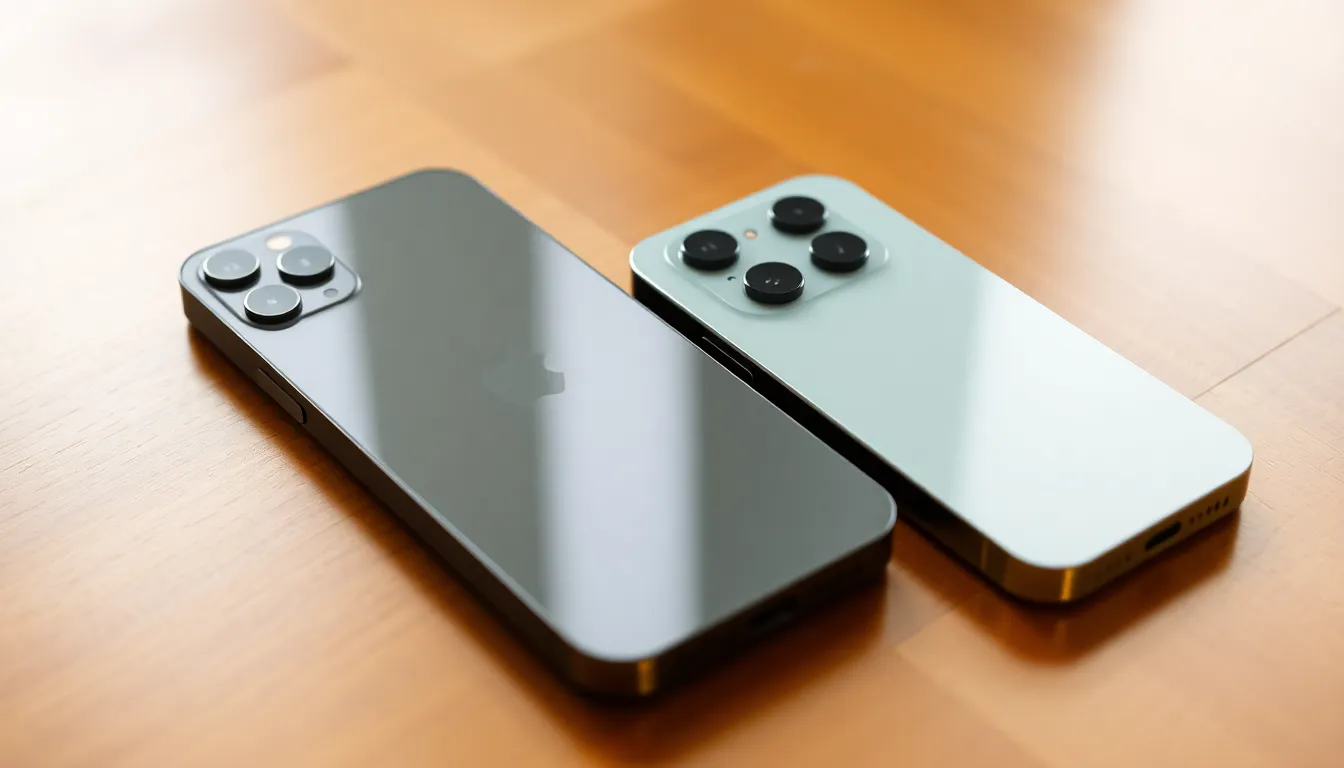In the world of smartphones, choosing between the iPhone 13 and iPhone 14 can feel like picking between a slice of pizza and a whole pizza—both delicious but one definitely offers more toppings. With Apple’s latest offerings, it’s easy to get lost in the sea of features, specs, and marketing buzz. But fear not! This decision doesn’t have to be as daunting as deciding between pineapple or no pineapple on your pizza.
Table of Contents
ToggleOverview of iPhone 13 and iPhone 14
The iPhone 13 and iPhone 14 each offer compelling features for users. Evaluating these models involves understanding key specifications and design differences.
Key Specifications Comparison
The iPhone 13 features a 6.1-inch Super Retina XDR display. Dual 12 MP cameras enable high-quality photography. It runs on the A15 Bionic chip, providing strong performance. In contrast, the iPhone 14 shares similar display specs but improves on camera capabilities with advanced software enhancements. Its A16 Bionic chip takes processing power to the next level. Battery life sees improvements too, with iPhone 14 lasting approximately 20 hours during video playback while iPhone 13 supports around 19 hours. Both devices support 5G connectivity, ensuring fast download speeds.
Design and Build Quality
Both the iPhone 13 and 14 exhibit sleek designs with premium materials. Apple fabricates each phone from durable glass and aluminum, enhancing durability and aesthetics. Users notice similar dimensions, but iPhone 14 introduces new color options, providing more personalization. The iPhone 13’s notch is slightly larger than that of the iPhone 14, which features a reduced notch size for a more immersive display experience. Additionally, both devices maintain the same IP68 water and dust resistance rating, ensuring longevity in various environments.
Performance Comparison

Performance stands as a crucial factor when choosing between the iPhone 13 and iPhone 14. Each model delivers impressive capabilities, but differences do exist.
Processor and Speed
The iPhone 13 features the A15 Bionic chip, which enables efficient multitasking and fluid performance. Enhanced graphics afford smooth gameplay and video rendering. In contrast, the iPhone 14 upgrades to the A16 Bionic chip. This newer processor not only improves overall speed but also enhances AI capabilities for advanced photography features. Speed tests demonstrate that the iPhone 14 performs better in demanding applications. Users can experience faster app launches and seamless transitions between tasks, making it ideal for those who require speed and efficiency.
Battery Life
Battery longevity plays a significant role in daily usage. With the iPhone 13, users enjoy approximately 19 hours of video playback on a full charge. The battery life is satisfactory for most activities. On the other hand, the iPhone 14 provides an improved battery life of about 20 hours for video playback. This slight enhancement offers extra convenience for users who tend to rely heavily on their devices throughout the day. Both models support fast charging, ensuring quick top-ups, but users looking for longevity may favor the iPhone 14 for its extended endurance.
Camera Capabilities
Both the iPhone 13 and iPhone 14 deliver impressive camera capabilities, making them desirable for photography enthusiasts and casual users alike.
Photography Features
The iPhone 13 features a dual 12 MP camera system that captures sharp images in various lighting conditions. It offers Night mode, Smart HDR 4, and Photographic Styles for personalized photos. In contrast, the iPhone 14 enhances this experience with a wider aperture on its main camera, allowing more light for stellar low-light performance. Users benefit from improved stabilization in the iPhone 14, which aids in delivering clearer images during motion. Advanced software upgrades also provide better computational photography, resulting in crisper details and vibrant colors in everyday shots.
Video Recording Options
Video recording options showcase notable advancements in both models. The iPhone 13 supports 4K recording at 60 frames per second, enabling smooth and high-quality videos. Users can experiment with features like Cinematic mode, which adds a depth-of-field effect, giving a professional touch to videos. The iPhone 14 builds on this foundation by introducing enhanced low-light capabilities for videography, improving performance further. Users can also enjoy Action mode, which stabilizes handheld recordings, resulting in steady footage even during movement. Overall, the iPhone 14’s video features elevate the standard set by the iPhone 13, catering to both amateur and experienced creators.
Software and Features
Both the iPhone 13 and iPhone 14 run on iOS, ensuring users access to Apple’s robust ecosystem and regular updates for security and performance. They offer compatibility with the latest apps, but the iPhone 14 supports more advanced features due to its enhanced hardware.
iOS Compatibility
iOS 16 powers both devices, delivering a sleek user experience with features like Focus modes and Live Text. Compatibility remains consistent, ensuring seamless integration with existing Apple services such as iCloud and Apple Music. Users can expect timely updates, maintaining device performance over time. With similar software foundations, both phones ensure users enjoy Apple’s continuous improvements, making their smartphones reliable companions.
Exclusive Features of iPhone 14
The iPhone 14 includes exclusive features like Emergency SOS via satellite, providing safety in remote areas with no cellular coverage. Additionally, it offers Crash Detection, which can automatically contact emergency services if an accident occurs. Photonic Engine enhances image processing for stunning low-light performance. Users benefit from the improved Action mode for video stabilization, creating professional-grade footage. Enhanced battery management paired with advanced connectivity ensures the iPhone 14 caters to users seeking cutting-edge technology.
Price and Value Proposition
Evaluating the price and value of the iPhone 13 versus the iPhone 14 demands a closer look at costs alongside features that matter most.
Cost Comparison
The iPhone 13 typically starts around $699 while the iPhone 14 begins at approximately $799. Price differences reflect enhancements and capabilities available in the iPhone 14. Buyers seeking budget-friendly options might favor the iPhone 13 due to its lower cost. However, those valuing cutting-edge tech might consider the extra $100 investment worthwhile. Promotions and trade-in options often lower upfront costs, which may influence decisions. Auction prices for refurbished units also vary, giving additional flexibility in budget constraints.
Long-Term Value
Long-term value plays a significant role in smartphone decisions. The iPhone 14 boasts advanced features that contribute to better longevity and support for new software updates. Users receive enhanced battery performance, making it a more reliable choice for daily tasks over time. Moreover, resale value remains strong for both models, yet the iPhone 14 commands higher rates due to its newer tech. In terms of overall investment, the improved capabilities of the iPhone 14 often justify its higher price tag, especially for users reliant on advanced photography and performance. Choosing either depends on immediate needs balanced against future benefits.
Choosing between the iPhone 13 and iPhone 14 ultimately hinges on individual needs and preferences. Those who value cutting-edge technology and enhanced features may find the iPhone 14 worth the investment. Its improved camera capabilities and performance enhancements cater to users who demand more from their devices.
On the other hand, the iPhone 13 remains a strong contender for those seeking a reliable smartphone without the latest upgrades. It’s a solid choice that offers excellent performance and features at a lower price point.
Ultimately, whether to opt for the iPhone 13 or 14 comes down to balancing current requirements with future-proofing for the years ahead.




